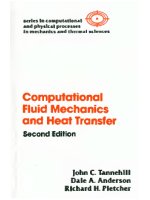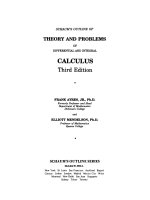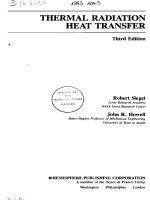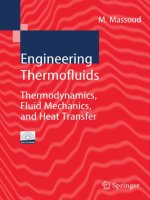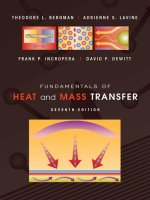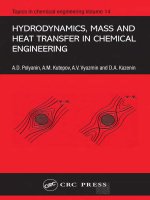Computational fluid mechanics and heat transfer third edition 3
Bạn đang xem bản rút gọn của tài liệu. Xem và tải ngay bản đầy đủ của tài liệu tại đây (1.19 MB, 39 trang )
Thermal resistance and the electrical analogy
§2.3
67
Figure 2.11 Conduction through two
unit-area slabs with a contact resistance.
Resistances for cylinders and for convection
As we continue developing our method of solving one-dimensional heat
conduction problems, we find that other avenues of heat flow may also be
expressed as thermal resistances, and introduced into the solutions that
we obtain. We also find that, once the heat conduction equation has been
solved, the results themselves may be used as new thermal resistances.
Example 2.5
Radial Heat Conduction in a Tube
Find the temperature distribution and the heat flux for the long hollow
cylinder shown in Fig. 2.12.
Solution.
Step 1. T = T (r )
Step 2.
1 ∂
r ∂r
r
∂T
∂r
+
˙
∂2T
q
1 ∂2T
+
+
=
2
2
2
r ∂φ
∂z
k
=0, since T ≠ T (φ, z)
Step 3. Integrate once: r
=0
1 ∂T
α ∂T
=0, since steady
∂T
= C1 ; integrate again: T = C1 ln r + C2
∂r
Step 4. T (r = ri ) = Ti and T (r = ro ) = To
68
Heat conduction, thermal resistance, and the overall heat transfer coefficient
§2.3
Figure 2.12 Heat transfer through a cylinder with a fixed wall
temperature (Example 2.5).
Step 5.
Ti = C1 ln ri + C2
To = C1 ln ro + C2
Step 6. T = Ti −
∆T
Ti − To
=−
C1 =
ln(ri /ro )
ln(ro /ri )
⇒
∆T
C =T +
ln ri
2
i
ln(ro /ri )
∆T
(ln r − ln ri ) or
ln(ro /ri )
ln(r /ri )
T − Ti
=
To − T i
ln(ro /ri )
(2.20)
Step 7. The solution is plotted in Fig. 2.12. We see that the temperature profile is logarithmic and that it satisfies both boundary
conditions. Furthermore, it is instructive to see what happens
when the wall of the cylinder is very thin, or when ri /ro is close
to 1. In this case:
ln(r /ri )
r
r − ri
−1=
ri
ri
Thermal resistance and the electrical analogy
§2.3
and
ro − ri
ri
ln(ro /ri )
Thus eqn. (2.20) becomes
r − ri
T − Ti
=
To − T i
ro − r i
which is a simple linear profile. This is the same solution that
we would get in a plane wall.
Step 8. At any station, r :
qradial = −k
l∆T
1
∂T
=+
∂r
ln(ro /ri ) r
So the heat flux falls off inversely with radius. That is reasonable, since the same heat flow must pass through an increasingly
large surface as the radius increases. Let us see if this is the case
for a cylinder of length l:
Q (W) = (2π r l) q =
2π kl∆T
≠ f (r )
ln(ro /ri )
(2.21)
Finally, we again recognize Ohm’s law in this result and write
the thermal resistance for a cylinder:
Rtcyl =
K
W
ln(ro /ri )
2π lk
(2.22)
This can be compared with the resistance of a plane wall:
Rtwall =
L
kA
K
W
Both resistances are inversely proportional to k, but each reflects a different geometry.
In the preceding examples, the boundary conditions were all the same
—a temperature specified at an outer edge. Next let us suppose that the
temperature is specified in the environment away from a body, with a
heat transfer coefficient between the environment and the body.
69
70
Heat conduction, thermal resistance, and the overall heat transfer coefficient
§2.3
Figure 2.13 Heat transfer through a cylinder with a convective
boundary condition (Example 2.6).
Example 2.6
A Convective Boundary Condition
A convective heat transfer coefficient around the outside of the cylinder in Example 2.5 provides thermal resistance between the cylinder
and an environment at T = T∞ , as shown in Fig. 2.13. Find the temperature distribution and heat flux in this case.
Solution.
Step 1 through 3. These are the same as in Example 2.5.
Step 4. The first boundary condition is T (r = ri ) = Ti . The second
boundary condition must be expressed as an energy balance at
the outer wall (recall Section 1.3).
qconvection = qconduction
at the wall
or
h(T − T∞ )r =ro = −k
∂T
∂r
r =ro
Step 5. From the first boundary condition we obtain Ti = C1 ln ri +
C2 . It is easy to make mistakes when we substitute the general
solution into the second boundary condition, so we will do it in
Thermal resistance and the electrical analogy
§2.3
detail:
h (C1 ln r + C2 ) − T∞
r =ro
= −k
∂
(C1 ln r + C2 )
∂r
r =ro
(2.23)
A common error is to substitute T = To on the lefthand side
instead of substituting the entire general solution. That will do
no good, because To is not an accessible piece of information.
Equation (2.23) reduces to:
h(T∞ − C1 ln ro − C2 ) =
kC1
ro
When we combine this with the result of the first boundary condition to eliminate C2 :
C1 = −
Ti − T∞
k (hro ) + ln(ro /ri )
=
T∞ − T i
1/Bi + ln(ro /ri )
Then
C 2 = Ti −
T∞ − Ti
ln ri
1/Bi + ln(ro /ri )
Step 6.
T =
T∞ − T i
ln(r /ri ) + Ti
1/Bi + ln(ro /ri )
This can be rearranged in fully dimensionless form:
T − Ti
ln(r /ri )
=
T∞ − T i
1/Bi + ln(ro /ri )
(2.24)
Step 7. Let us fix a value of ro /ri —say, 2—and plot eqn. (2.24) for
several values of the Biot number. The results are included
in Fig. 2.13. Some very important things show up in this plot.
When Bi
1, the solution reduces to the solution given in Example 2.5. It is as though the convective resistance to heat flow
were not there. That is exactly what we anticipated in Section 1.3
for large Bi. When Bi
1, the opposite is true: (T −Ti ) (T∞ −Ti )
71
72
Heat conduction, thermal resistance, and the overall heat transfer coefficient
§2.3
Figure 2.14 Thermal circuit with two
resistances.
remains on the order of Bi, and internal conduction can be neglected. How big is big and how small is small? We do not
really have to specify exactly. But in this case Bi < 0.1 signals
constancy of temperature inside the cylinder with about ±3%.
Bi > 20 means that we can neglect convection with about 5%
error.
Ti − T∞
1
∂T
=k
∂r
1/Bi + ln(ro /ri ) r
This can be written in terms of Q (W) = qradial (2π r l) for a cylinder of length l:
Step 8. qradial = −k
Q=
Ti − T ∞
T i − T∞
=
ln(ro /ri )
Rtconv + Rtcond
+
2π kl
h 2π ro l
1
(2.25)
Equation (2.25) is once again analogous to Ohm’s law. But this time
the denominator is the sum of two thermal resistances, as would be
the case in a series circuit. We accordingly present the analogous
electrical circuit in Fig. 2.14.
The presence of convection on the outside surface of the cylinder
causes a new thermal resistance of the form
Rtconv =
1
hA
(2.26)
where A is the surface area over which convection occurs.
Example 2.7
Critical Radius of Insulation
An interesting consequence of the preceding result can be brought out
with a specific example. Suppose that we insulate a 0.5 cm O.D. copper
steam line with 85% magnesia to prevent the steam from condensing
Thermal resistance and the electrical analogy
§2.3
Figure 2.15 Thermal circuit for an
insulated tube.
too rapidly. The steam is under pressure and stays at 150◦ C. The
copper is thin and highly conductive—obviously a tiny resistance in
series with the convective and insulation resistances, as we see in
Fig. 2.15. The condensation of steam inside the tube also offers very
little resistance.3 But on the outside, a heat transfer coefficient of h
= 20 W/m2 K offers fairly high resistance. It turns out that insulation
can actually improve heat transfer in this case.
The two significant resistances, for a cylinder of unit length (l =
1 m), are
ln(ro /ri )
ln(ro /ri )
=
K/W
2π kl
2π (0.074)
1
1
=
=
K/W
2π (20)ro
2π ro h
Rtcond =
Rtconv
Figure 2.16 is a plot of these resistances and their sum. A very interesting thing occurs here. Rtconv falls off rapidly when ro is increased,
because the outside area is increasing. Accordingly, the total resistance passes through a minimum in this case. Will it always do so?
To find out, we differentiate eqn. (2.25), again setting l = 1 m:
dQ
=
dro
(Ti − T∞ )
ln(ro /ri )
+
2π k
2π ro h
1
2
−
1
2π ro2 h
+
1
2π kro
=0
When we solve this for the value of ro = rcrit at which Q is maximum
and the total resistance is minimum, we obtain
Bi = 1 =
hrcrit
k
(2.27)
In the present example, adding insulation will increase heat loss in3
Condensation heat transfer is discussed in Chapter 8. It turns out that h is generally
enormous during condensation so that Rtcondensation is tiny.
73
Heat conduction, thermal resistance, and the overall heat transfer coefficient
rcrit = 1.48 ri
4
Thermal resistance, Rt (K/W)
74
§2.3
Rtcond + Rtconv
Rtconv
2
Rtcond
0
1.0
1.5
2.0
2.5
2.32
Radius ratio, ro/ri
Figure 2.16 The critical radius of insulation (Example 2.7),
written for a cylinder of unit length (l = 1 m).
stead of reducing it, until rcrit = k h = 0.0037 m or rcrit /ri = 1.48.
Indeed, insulation will not even start to do any good until ro /ri = 2.32
or ro = 0.0058 m. We call rcrit the critical radius of insulation.
There is an interesting catch here. For most cylinders, rcrit < ri and
the critical radius idiosyncrasy is of no concern. If our steam line had a 1
cm outside diameter, the critical radius difficulty would not have arisen.
When cooling smaller diameter cylinders, such as electrical wiring, the
critical radius must be considered, but one need not worry about it in
the design of most large process equipment.
Resistance for thermal radiation
We saw in Chapter 1 that the net radiation exchanged by two objects is
given by eqn. (1.34):
Qnet = A1 F1–2 σ T14 − T24
(1.34)
When T1 and T2 are close, we can approximate this equation using a
radiation heat transfer coefficient, hrad . Specifically, suppose that the
temperature difference, ∆T = T1 − T2 , is small compared to the mean
temperature, Tm = (T1 + T2 ) 2. Then we can make the following expan-
Thermal resistance and the electrical analogy
§2.3
sion and approximation:
Qnet = A1 F1–2 σ T14 − T24
= A1 F1–2 σ (T12 + T22 )(T12 − T22 )
= A1 F1–2 σ
(T12 + T22 )
(T1 + T2 ) (T1 − T2 )
2 + (∆T )2 /2
= 2Tm
=2Tm
=∆T
3
A1 4σ Tm
F1–2 ∆T
(2.28)
≡hrad
2 or (∆T /T )2 /4
2Tm
where the last step assumes that (∆T )2 /2
m
Thus, we have identified the radiation heat transfer coefficient
Qnet = A1 hrad ∆T
hrad =
3
4σ Tm
F1–2
for
∆T Tm
2
4
1
1.
(2.29)
This leads us immediately to the introduction of a radiation thermal resistance, analogous to that for convection:
Rtrad =
1
A1 hrad
(2.30)
For the special case of a small object (1) in a much larger environment
(2), the transfer factor is given by eqn. (1.35) as F1–2 = ε1 , so that
3
ε1
hrad = 4σ Tm
(2.31)
If the small object is black, its emittance is ε1 = 1 and hrad is maximized.
For a black object radiating near room temperature, say Tm = 300 K,
hrad = 4(5.67 × 10−8 )(300)3
6 W/m2 K
This value is of approximately the same size as h for natural convection
into a gas at such temperatures. Thus, the heat transfer by thermal radiation and natural convection into gases are similar. Both effects must be
taken into account. In forced convection in gases, on the other hand, h
might well be larger than hrad by an order of magnitude or more, so that
thermal radiation can be neglected.
75
76
Heat conduction, thermal resistance, and the overall heat transfer coefficient
§2.3
Example 2.8
An electrical resistor dissipating 0.1 W has been mounted well away
from other components in an electronical cabinet. It is cylindrical
with a 3.6 mm O.D. and a length of 10 mm. If the air in the cabinet
is at 35◦ C and at rest, and the resistor has h = 13 W/m2 K for natural
convection and ε = 0.9, what is the resistor’s temperature? Assume
that the electrical leads are configured so that little heat is conducted
into them.
Solution. The resistor may be treated as a small object in a large
isothermal environment. To compute hrad , let us estimate the resistor’s temperature as 50◦ C. Then
Tm = (35 + 50)/2
43◦ C = 316 K
so
3
ε = 4(5.67 × 10−8 )(316)3 (0.9) = 6.44 W/m2 K
hrad = 4σ Tm
Heat is lost by natural convection and thermal radiation acting in
parallel. To find the equivalent thermal resistance, we combine the
two parallel resistances as follows:
1
1
1
=
+
= Ahrad + Ah = A hrad + h
Rtequiv
Rtrad
Rtconv
Thus,
Requiv =
1
A hrad + h
A calculation shows A = 133 mm2 = 1.33 × 10−4 m2 for the resistor
surface. Thus, the equivalent thermal resistance is
Rtequiv =
1
= 386.8 K/W
(1.33 × 10−4 )(13 + 6.44)
Since
Q=
Tresistor − Tair
Rtequiv
We find
Tresistor = Tair + Q · Rtequiv = 35 + (0.1)(386.8) = 73.68 ◦ C
Thermal resistance and the electrical analogy
§2.3
77
Tresistor
Qconv
Qrad
1
R t conv=
–
hA
Qconv
Tresistor
Tair
R t rad =
1
h
rad
A
Figure 2.17 An electrical resistor cooled
by convection and radiation.
Qrad
We guessed a resistor temperature of 50◦ C in finding hrad . Recomputing with this higher temperature, we have Tm = 327 K and
hrad = 7.17 W/m2 K. If we repeat the rest of the calculation, we get a
new value Tresistor = 72.3◦ C. Further iteration is not needed.
Since the use of hrad is an approximation, we should check its
applicability:
1
4
∆T
Tm
2
=
1
4
72.3 − 35.0
327
2
= 0.00325
1
In this case, the approximation is a very good one.
Example 2.9
Suppose that power to the resistor in Example 2.8 is turned off. How
long does it take to cool? The resistor has k
10 W/m·K, ρ
2000 kg/m3 , and cp 700 J/kg·K.
Solution. The lumped capacity model, eqn. (1.22), may be applicable. To find out, we check the resistor’s Biot number, noting that
the parallel convection and radiation processes have an effective heat
78
Heat conduction, thermal resistance, and the overall heat transfer coefficient
§2.4
transfer coefficient heff = h + hrad = 18.44 W/m2 K. Then,
Bi =
(18.44)(0.0036/2)
heff ro
=
= 0.0033
k
10
1
so eqn. (1.22) can be used to describe the cooling process. The time
constant is
T =
ρcp V
(2000)(700)π (0.010)(0.0036)2 /4
=
= 58.1 s
heff A
(18.44)(1.33 × 10−4 )
From eqn. (1.22) with T0 = 72.3◦ C
Tresistor = 35.0 + (72.3 − 35.0)e−t/58.1 ◦ C
Ninety-five percent of the total temperature drop has occured when
t = 3T = 174 s.
2.4
Overall heat transfer coefficient, U
Definition
We often want to transfer heat through composite resistances, as shown
in Fig. 2.18. It is very convenient to have a number, U , that works like
this4 :
Q = U A ∆T
(2.32)
This number, called the overall heat transfer coefficient, is defined largely
by the system, and in many cases it proves to be insensitive to the operating conditions of the system. In Example 2.6, for example, we can use
the value Q given by eqn. (2.25) to get
U=
1
Q (W)
=
ro ln(ro /ri )
1
2π ro l (m2 ) ∆T (◦ C)
+
k
h
(W/m2 K)
(2.33)
We have based U on the outside area, Ao = 2π ro l, in this case. We might
instead have based it on inside area, Ai = 2π ri l, and obtained
U=
4
1
ri ln(ro /ri )
+
k
hro
ri
(2.34)
This U must not be confused with internal energy. The two terms should always
be distinct in context.
Overall heat transfer coefficient, U
§2.4
79
Figure 2.18 A thermal circuit with many
resistances.
It is therefore important to remember which area an overall heat transfer coefficient is based on. It is particularly important that A and U be
consistent when we write Q = U A ∆T .
Example 2.10
Estimate the overall heat transfer coefficient for the tea kettle shown
in Fig. 2.19. Note that the flame convects heat to the thin aluminum.
The heat is then conducted through the aluminum and finally convected by boiling into the water.
Solution. We need not worry about deciding which area to base A
on because the area normal to the heat flux vector does not change.
We simply write the heat flow
Q=
Tflame − Tboiling water
∆T
=
1
L
1
Rt
+
+
hA kAl A hb A
and apply the definition of U
U=
Q
1
=
L
1
1
A∆T
+
+
h kAl
hb
Let us see what typical numbers would look like in this example: h
might be around 200 W/m2 K; L kAl might be 0.001 m/(160 W/m·K)
or 1/160,000 W/m2 K; and hb is quite large— perhaps about 5000
W/m2 K. Thus:
U
1
= 192.1 W/m2 K
1
1
1
+
+
200 160, 000 5000
80
Heat conduction, thermal resistance, and the overall heat transfer coefficient
Figure 2.19
§2.4
Heat transfer through the bottom of a tea kettle.
It is clear that the first resistance is dominant, as is shown in Fig. 2.19.
Notice that in such cases
U A → 1/Rtdominant
(2.35)
where A is any area (inside or outside) in the thermal circuit.
Experiment 2.1
Boil water in a paper cup over an open flame and explain why you can
do so. [Recall eqn. (2.35) and see Problem 2.12.]
Example 2.11
A wall consists of alternating layers of pine and sawdust, as shown
in Fig. 2.20). The sheathes on the outside have negligible resistance
and h is known on the sides. Compute Q and U for the wall.
Solution. So long as the wood and the sawdust do not differ dramatically from one another in thermal conductivity, we can approximate
the wall as a parallel resistance circuit, as shown in the figure.5 The
5
For this approximation to be exact, the resistances must be equal. If they differ
radically, the problem must be treated as two-dimensional.
Overall heat transfer coefficient, U
§2.4
Figure 2.20
Heat transfer through a composite wall.
total thermal resistance of the circuit is
1
Rttotal = Rtconv +
1
Rtpine
+
+ Rtconv
1
Rtsawdust
Thus
Q=
∆T
=
Rttotal
1
hA
T∞1 − T∞r
1
+
kp Ap
L
+
k s As
+
1
hA
L
and
U=
Q
=
A∆T
2
h
1
+
1
kp Ap
L A
+
ks As
L A
The approach illustrated in this example is very widely used in calculating U values for the walls and roofs houses and buildings. The thermal
resistances of each structural element — insulation, studs, siding, doors,
windows, etc. — are combined to calculate U or Rttotal , which is then used
together with weather data to estimate heating and cooling loads [2.5].
81
82
Heat conduction, thermal resistance, and the overall heat transfer coefficient
Table 2.2
Typical ranges or magnitudes of U
Heat Exchange Configuration
Walls and roofs dwellings with a 24 km/h
outdoor wind:
• Insulated roofs
• Finished masonry walls
• Frame walls
• Uninsulated roofs
Single-pane windows
Air to heavy tars and oils
Air to low-viscosity liquids
Air to various gases
Steam or water to oil
Liquids in coils immersed in liquids
Feedwater heaters
Air condensers
Steam-jacketed, agitated vessels
Shell-and-tube ammonia condensers
Steam condensers with 25◦ C water
Condensing steam to high-pressure
boiling water
†
§2.4
U (W/m2 K)
0.3−2
0.5−6
0.3−5
1.2−4
∼ 6†
As low as 45
As high as 600
60−550
60−340
110−2, 000
110−8, 500
350−780
500−1, 900
800−1, 400
1, 500−5, 000
1, 500−10, 000
Main heat loss is by infiltration.
Typical values of U
In a fairly general use of the word, a heat exchanger is anything that
lies between two fluid masses at different temperatures. In this sense a
heat exchanger might be designed either to impede or to enhance heat
exchange. Consider some typical values of U shown in Table 2.2, which
were assembled from a variety of technical sources. If the exchanger
is intended to improve heat exchange, U will generally be much greater
than 40 W/m2 K. If it is intended to impede heat flow, it will be less than
10 W/m2 K—anywhere down to almost perfect insulation. You should
have some numerical concept of relative values of U , so we recommend
that you scrutinize the numbers in Table 2.2. Some things worth bearing
in mind are:
• The fluids with low thermal conductivities, such as tars, oils, or any
of the gases, usually yield low values of h. When such fluid flows
on one side of an exchanger, U will generally be pulled down.
Overall heat transfer coefficient, U
§2.4
• Condensing and boiling are very effective heat transfer processes.
They greatly improve U but they cannot override one very small
value of h on the other side of the exchange. (Recall Example 2.10.)
In fact:
• For a high U , all resistances in the exchanger must be low.
• The highly conducting liquids, such as water and liquid metals, give
high values of h and U .
Fouling resistance
Figure 2.21 shows one of the simplest forms of a heat exchanger—a pipe.
The inside is new and clean on the left, but on the right it has built up a
layer of scale. In conventional freshwater preheaters, for example, this
scale is typically MgSO4 (magnesium sulfate) or CaSO4 (calcium sulfate)
which precipitates onto the pipe wall after a time. To account for the resistance offered by these buildups, we must include an additional, highly
empirical resistance when we calculate U . Thus, for the pipe shown in
Fig. 2.21,
U
older pipe
based on Ai
=
1
1
hi
+
ri ln(ro /rp )
kinsul
Figure 2.21
+
ri ln(rp /ri )
kpipe
+
The fouling of a pipe.
ri
ro h o
+ Rf
83
84
Heat conduction, thermal resistance, and the overall heat transfer coefficient
Table 2.3
§2.4
Some typical fouling resistances for a unit area.
Fouling Resistance
Rf (m2 K/W)
Fluid and Situation
Distilled water
Seawater
Treated boiler feedwater
Clean river or lake water
About the worst waters used in heat
exchangers
No. 6 fuel oil
Transformer or lubricating oil
Most industrial liquids
Most refinery liquids
Steam, non-oil-bearing
Steam, oil-bearing (e.g., turbine
exhaust)
Most stable gases
Flue gases
Refrigerant vapors (oil-bearing)
0.0001
0.0001 − 0.0004
0.0001 − 0.0002
0.0002 − 0.0006
< 0.0020
0.0001
0.0002
0.0002
0.0002 − 0.0009
0.0001
0.0003
0.0002 − 0.0004
0.0010 − 0.0020
0.0040
where Rf is a fouling resistance for a unit area of pipe (in m2 K/W). And
clearly
Rf ≡
1
1
−
Uold
Unew
(2.36)
Some typical values of Rf are given in Table 2.3. These values have
been adapted from [2.6] and [2.7]. Notice that fouling has the effect of
adding a resistance in series on the order of 10−4 m2 K/W. It is rather like
another heat transfer coefficient, hf , on the order of 10,000 W/m2 K in
series with the other resistances in the exchanger.
The tabulated values of Rf are given to only one significant figure because they are very approximate. Clearly, exact values would have to be
referred to specific heat exchanger configurations, to particular fluids, to
fluid velocities, to operating temperatures, and to age [2.8, 2.9]. The resistance generally drops with increased velocity and increases with temperature and age. The values given in the table are based on reasonable
Overall heat transfer coefficient, U
§2.4
maintenance and the use of conventional shell-and-tube heat exchangers.
With misuse, a given heat exchanger can yield much higher values of Rf .
Notice too, that if U
1, 000 W/m2 K, fouling will be unimportant
because it will introduce a negligibly small resistance in series. Thus,
in a water-to-water heat exchanger, for which U is on the order of 2000
W/m2 K, fouling might be important; but in a finned-tube heat exchanger
with hot gas in the tubes and cold gas passing across the fins on them, U
might be around 200 W/m2 K, and fouling will be usually be insignificant.
Example 2.12
You have unpainted aluminum siding on your house and the engineer
has based a heat loss calculation on U = 5 W/m2 K. You discover that
air pollution levels are such that Rf is 0.0005 m2 K/W on the siding.
Should the engineer redesign the siding?
Solution. From eqn. (2.36) we get
1
Ucorrected
=
1
Uuncorrected
+ Rf = 0.2000 + 0.0005 m2 K/W
Therefore, fouling is entirely irrelevant to domestic heat loads.
Example 2.13
Since the engineer did not fail you in the preceding calculation, you
entrust him with the installation of a heat exchanger at your plant.
He installs a water-cooled steam condenser with U = 4000 W/m2 K.
You discover that he used water-side fouling resistance for distilled
water but that the water flowing in the tubes is not clear at all. How
did he do this time?
Solution. Equation (2.36) and Table 2.3 give
1
Ucorrected
=
1
+ (0.0006 to 0.0020)
4000
= 0.00085 to 0.00225 m2 K/W
Thus, U is reduced from 4,000 to between 444 and 1,176 W/m2 K.
Fouling is crucial in this case, and the engineer was in serious error.
85
86
Chapter 2: Heat conduction, thermal resistance, and the overall heat transfer coefficient
2.5
Summary
Four things have been done in this chapter:
• The heat diffusion equation has been established. A method has
been established for solving it in simple problems, and some important results have been presented. (We say much more about
solving the heat diffusion equation in Part II of this book.)
• We have explored the electric analogy to steady heat flow, paying
special attention to the concept of thermal resistance. We exploited
the analogy to solve heat transfer problems in the same way we
solve electrical circuit problems.
• The overall heat transfer coefficient has been defined, and we have
seen how to build it up out of component resistances.
• Some practical problems encountered in the evaluation of overall
heat transfer coefficients have been discussed.
Three very important things have not been considered in Chapter 2:
• In all evaluations of U that involve values of h, we have taken these
values as given information. In any real situation, we must determine correct values of h for the specific situation. Part III deals with
such determinations.
• When fluids flow through heat exchangers, they give up or gain
energy. Thus, the driving temperature difference varies through
the exchanger. (Problem 2.14 asks you to consider this difficulty
in its simplest form.) Accordingly, the design of an exchanger is
complicated. We deal with this problem in Chapter 3.
• The heat transfer coefficients themselves vary with position inside
many types of heat exchangers, causing U to be position-dependent.
Problems
2.1
Prove that if k varies linearly with T in a slab, and if heat transfer is one-dimensional and steady, then q may be evaluated
precisely using k evaluated at the mean temperature in the
slab.
Problems
87
2.2
Invent a numerical method for calculating the steady heat flux
through a plane wall when k(T ) is an arbitrary function. Use
the method to predict q in an iron slab 1 cm thick if the temperature varies from −100◦ C on the left to 400◦ C on the right.
How far would you have erred if you had taken kaverage =
(kleft + kright )/2?
2.3
The steady heat flux at one side of a slab is a known value qo .
The thermal conductivity varies with temperature in the slab,
and the variation can be expressed with a power series as
i=n
Ai T i
k=
i=0
(a) Start with eqn. (2.10) and derive an equation that relates
T to position in the slab, x. (b) Calculate the heat flux at any
position in the wall from this expression using Fourier’s law.
Is the resulting q a function of x?
2.4
Combine Fick’s law with the principle of conservation of mass
(of the dilute species) in such a way as to eliminate j1 , and
obtain a second-order differential equation in m1 . Discuss the
importance and the use of the result.
2.5
Solve for the temperature distribution in a thick-walled pipe
if the bulk interior temperature and the exterior air temperature, T∞i , and T∞o , are known. The interior and the exterior
heat transfer coefficients are hi and ho , respectively. Follow
the method in Example 2.1 and put your result in the dimensionless form:
T − T∞i
= fn (Bii , Bio , r /ri , ro /ri )
T∞i − T∞o
2.6
Put the boundary conditions from Problem 2.5 into dimensionless form so that the Biot numbers appear in them. Let the Biot
numbers approach infinity. This should get you back to the
boundary conditions for Example 2.5. Therefore, the solution
that you obtain in Problem 2.5 should reduce to the solution of
Example 2.5 when the Biot numbers approach infinity. Show
that this is the case.
88
Chapter 2: Heat conduction, thermal resistance, and the overall heat transfer coefficient
Figure 2.22 Configuration for
Problem 2.8.
2.7
Write an accurate explanation of the idea of critical radius of
insulation that your kid brother or sister, who is still in grade
school, could understand. (If you do not have an available kid,
borrow one to see if your explanation really works.)
2.8
The slab shown in Fig. 2.22 is embedded on five sides in insulating materials. The sixth side is exposed to an ambient temperature through a heat transfer coefficient. Heat is generated
in the slab at the rate of 1.0 kW/m3 The thermal conductivity
of the slab is 0.2 W/m·K. (a) Solve for the temperature distribution in the slab, noting any assumptions you must make. Be
careful to clearly identify the boundary conditions. (b) Evaluate T at the front and back faces of the slab. (c) Show that your
solution gives the expected heat fluxes at the back and front
faces.
2.9
Consider the composite wall shown in Fig. 2.23. The concrete
and brick sections are of equal thickness. Determine T1 , T2 ,
q, and the percentage of q that flows through the brick. To
do this, approximate the heat flow as one-dimensional. Draw
the thermal circuit for the wall and identify all four resistances
before you begin.
2.10
Compute Q and U for Example 2.11 if the wall is 0.3 m thick.
Five (each) pine and sawdust layers are 5 and 8 cm thick, re-
Problems
89
spectively; and the heat transfer coefficients are 10 on the left
and 18 on the right. T∞1 = 30◦ C and T∞r = 10◦ C.
2.11
Compute U for the slab in Example 1.2.
2.12
Consider the tea kettle in Example 2.10. Suppose that the kettle holds 1 kg of water (about 1 liter) and that the flame impinges on 0.02 m2 of the bottom. (a) Find out how fast the water temperature is increasing when it reaches its boiling point,
and calculate the temperature of the bottom of the kettle immediately below the water if the gases from the flame are at
500◦ C when they touch the bottom of the kettle. Assume that
the heat capacitance of the aluminum kettle is negligible. (b)
There is an old parlor trick in which one puts a paper cup of
water over an open flame and boils the water without burning
the paper (see Experiment 2.1). Explain this using an electrical
analogy. [(a): dT /dt = 0.37◦ C/s.]
2.13
Copper plates 2 mm and 3 mm in thickness are processed
rather lightly together. Non-oil-bearing steam condenses under pressure at Tsat = 200◦ C on one side (h = 12, 000 W/m2 K)
and methanol boils under pressure at 130◦ Con the other (h =
9000 W/m2 K). Estimate U and q initially and after extended
service. List the relevant thermal resistances in order of decreasing importance and suggest whether or not any of them
can be ignored.
2.14
0.5 kg/s of air at 20◦ C moves along a channel that is 1 m from
wall to wall. One wall of the channel is a heat exchange surface
Figure 2.23 Configuration for
Problem 2.9.
90
Chapter 2: Heat conduction, thermal resistance, and the overall heat transfer coefficient
(U = 300 W/m2 K) with steam condensing at 120◦ C on its back.
Determine (a) q at the entrance; (b) the rate of increase of temperature of the fluid with x at the entrance; (c) the temperature
and heat flux 2 m downstream. [(c): T2m = 89.7◦ C.]
2.15
An isothermal sphere 3 cm in diameter is kept at 80◦ C in a
large clay region. The temperature of the clay far from the
sphere is kept at 10◦ C. How much heat must be supplied to
the sphere to maintain its temperature if kclay = 1.28 W/m·K?
(Hint: You must solve the boundary value problem not in the
sphere but in the clay surrounding it.) [Q = 16.9 W.]
2.16
Is it possible to increase the heat transfer from a convectively
cooled isothermal sphere by adding insulation? Explain fully.
2.17
A wall consists of layers of metals and plastic with heat transfer coefficients on either side. U is 255 W/m2 K and the overall
temperature difference is 200◦ C. One layer in the wall is stainless steel (k = 18 W/m·K) 3 mm thick. What is ∆T across the
stainless steel?
2.18
A 1% carbon-steel sphere 20 cm in diameter is kept at 250◦ C on
the outside. It has an 8 cm diameter cavity containing boiling
water (hinside is very high) which is vented to the atmosphere.
What is Q through the shell?
2.19
A slab is insulated on one side and exposed to a surrounding temperature, T∞ , through a heat transfer coefficient on the
other. There is nonuniform heat generation in the slab such
˙ =[A (W/m4 )][x (m)], where x = 0 at the insulated wall
that q
and x = L at the cooled wall. Derive the temperature distribution in the slab.
2.20
800 W/m3 of heat is generated within a 10 cm diameter nickelsteel sphere for which k = 10 W/m·K. The environment is at
20◦ C and there is a natural convection heat transfer coefficient
of 10 W/m2 K around the outside of the sphere. What is its
center temperature at the steady state? [21.37◦ C.]
2.21
An outside pipe is insulated and we measure its temperature
with a thermocouple. The pipe serves as an electrical resis˙ is known from resistance and current meatance heater, and q
Problems
91
surements. The inside of the pipe is cooled by the flow of liquid with a known bulk temperature. Evaluate the heat transfer
coefficient, h, in terms of known information. The pipe dimensions and properties are known. [Hint: Remember that h is not
known and we cannot use a boundary condition of the third
kind at the inner wall to get T (r ).]
2.22
Consider the hot water heater in Problem 1.11. Suppose that it
is insulated with 2 cm of a material for which k = 0.12 W/m·K,
and suppose that h = 16 W/m2 K. Find (a) the time constant
T for the tank, neglecting the casing and insulation; (b) the
initial rate of cooling in ◦ C/h; (c) the time required for the water
to cool from its initial temperature of 75◦ C to 40◦ C; (d) the
percentage of additional heat loss that would result if an outer
casing for the insulation were held on by eight steel rods, 1 cm
in diameter, between the inner and outer casings.
2.23
A slab of thickness L is subjected to a constant heat flux, q1 , on
the left side. The right-hand side if cooled convectively by an
environment at T∞ . (a) Develop a dimensionless equation for
the temperature of the slab. (b) Present dimensionless equation for the left- and right-hand wall temperatures as well. (c)
If the wall is firebrick, 10 cm thick, q1 is 400 W/m2 , h = 20
W/m2 K, and T∞ = 20◦ C, compute the lefthand and righthand
temperatures.
2.24
Heat flows steadily through a stainless steel wall of thickness
Lss = 0.06 m, with a variable thermal conductivity of kss = 1.67 +
0.0143 T(◦ C). It is partially insulated on the right side with glass
wool of thickness Lgw = 0.1 m, with a thermal conductivity
of kgw = 0.04. The temperature on the left-hand side of the
stainless stell is 400◦ Cand on the right-hand side if the glass
wool is 100◦ C. Evaluate q and Ti .
2.25
Rework Problem 1.29 with a heat transfer coefficient, ho = 40
W/m2 K on the outside (i.e., on the cold side).
2.26
A scientist proposes an experiment for the space shuttle in
which he provides underwater illumination in a large tank of
water at 20◦ C, using a 3 cm diameter spherical light bulb. What
is the maximum wattage of the bulb in zero gravity that will
not boil the water?


